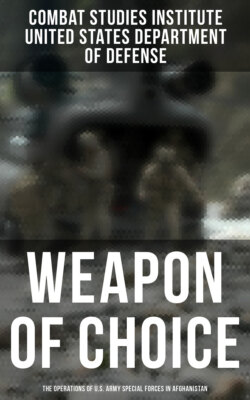Читать книгу Weapon of Choice: The Operations of U.S. Army Special Forces in Afghanistan - Combat Studies Institute - Страница 16
На сайте Литреса книга снята с продажи.
Thinking Ahead: Senior Liaison Officers for Resistance Leaders
ОглавлениеThe 5th SFG had identified only two key resistance leaders in northern Afghanistan and none in the south based on initial intelligence briefings. It had learned little more than the names—Fahim Khan of the Northern Alliance and Rashid Dostum. These were the highestranking military commanders, and it was assumed that each had considerable political influence. In the UN, a delegate from Fahim Khan’s faction had been accepted officially as the political representative for Afghanistan. Detailed personal information about Fahim Khan and Rashid Dostum—ethnicity and education; personalities and backgrounds; the size of their forces; and the tactical state of their soldiers, weapons, and equipment—was not yet fully available.
Figure 28. TF Dagger Commander COL Mulholland gives GEN Myers (CJCS) an update at K2.
Despite that limitation, COL Mulholland chose to build his UW campaign around those two Afghan leaders. He believed that “it was going to be important to put a senior level of leadership” with Dostum and Fahim Khan “to help influence the political battlefield as well as the military.” He felt that he could accomplish this by using two of his three lieutenant colonel battalion commanders as liaison officers to the two Afghan warlords. Mulholland recounted that battalion commanders provided a more senior presence with these significant Afghan leaders. In addition, they were to establish sectors of responsibility. He contended that this arrangement would provide the Afghan generals “with an extra level of experience and expertise” and “disseminate the command and control dilemma.”
As the campaign progressed, the planning staffs anticipated that a Pashtun counterpart to Dostum and Fahim Khan would emerge to rally resistance in the south. If that happened, Mulholland would have a third battalion commander to send to that leader. While this concept fragmented the three battalion staffs and gave initial command and control of nine Special Forces companies and their ODAs directly to him, Mulholland considered it to be necessary to accomplish the assigned mission. It also allowed him to fill JSOTF-North staff vacancies.
